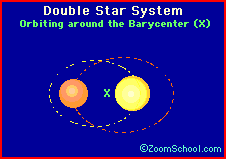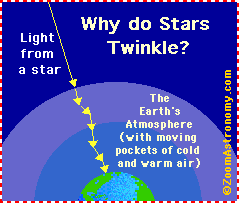What is a star?
Each star in the sky is an enormous glowing ball of gas. Our sun is a medium-sized star.
Stars can live for billions of years. A star is born when an enormous cloud of hydrogen gas collapses until it is hot enough to burn nuclear fuel (producing tremendous amounts heat and radiation). As the nuclear fuel runs out (in about 5 billion years), the star expands and the core contracts, becoming a giant star which eventually explodes and turns into a dim, cool object (a black dwarf, neutron star, or black hole, depending on its initial mass). The largest stars have the shortest life span (still billions of years); more massive stars burn hotter and faster than their smaller counterparts (like the Sun).
The composition of stars is studied using spectroscopy in which their visible light (the spectrum) is studied.
Group of stars
 In the universe, most stars occur in groups of at least two stars. Two stars that are locked in elliptical orbit around their center of mass (their barycenter) are called a binary star system. About half of all stars are in a binary star system.
In the universe, most stars occur in groups of at least two stars. Two stars that are locked in elliptical orbit around their center of mass (their barycenter) are called a binary star system. About half of all stars are in a binary star system.
A globular star cluster is a spherical group of up to a million stars held together by gravity. These remote objects lie mostly around the central bulge of spiral galaxies.
There are larger groups of stars, called clusters. These are relatively unorganized collections of stars. An open cluster is a loose collection of up to about 1,000 stars. Examples of open clusters include the Pleiades and Hyades.
Huge, organized collections of stars are called galaxies. Our solar system is located in the Milky Way Galaxy, a spiral galaxy. For more in-depth information on galaxies, click here.
All groups of stars are held together by gravitational forces.
Why are stars hot and bright?
Nuclear fusion and nucleosynthesis
Stars are giant nuclear reactors. In the center of stars, atoms are taken apart by tremendous atomic collisions that alter the atomic structure and release an enormous amount of energy. This makes stars hot and bright. In most stars, the primary reaction converts hydrogen atoms into helium atoms, releasing an enormous amount of energy. This reaction is called nuclear fusion because it fused the nuclei (center) of atoms together, forming a new nucleus. The process of forming a new nucleus (and element) is nucleosynthesis.
For more information on nuclear fusion in stars, click here.
What is the closest star?
The closest star to us is the sun! Other than that, the closest star is Proxima Centauri, aka Alpha Centauri C (the dimmest star in the Alpha Centauri system). Proxima Centauri is 4.3 light-years from the Sun. It has an absolute magnitude of 15.5.
Why do stars twinkle?
 The scientific name for the twinkling of stars is stellar scintillation (or astronomical scintillation). Stars twinkle when we see them from the Earth’s surface because we are viewing them through thick layers of turbulent (moving) air in the Earth’s atmosphere.
The scientific name for the twinkling of stars is stellar scintillation (or astronomical scintillation). Stars twinkle when we see them from the Earth’s surface because we are viewing them through thick layers of turbulent (moving) air in the Earth’s atmosphere.
Stars (except for the Sun) appear as tiny dots in the sky; as their light travels through the many layers of the Earth’s atmosphere, the light of the star is bent (refracted) many times and in random directions (light is bent when it hits a change in density - like a pocket of cold air or hot air). This random refraction results in the star winking out (it looks as though the star moves a bit, and our eye interprets this as twinkling).
Stars closer to the horizon appear to twinkle more than stars that are overhead - this is because the light of stars near the horizon has to travel through more air than stars overhead and subject to more refraction. Also, planets do not usually twinkle - they are big enough that this effect is not noticeable (except when the air is extremely turbulent).
Stars would not appear to twinkle if we viewed them from outer space (or from a planet/moon that didn’t have an atmosphere).
Stellar wind
Stellar wind is ionized gas that is ejected from the surface of a star (including the Sun). Older (evolved) stars give off stronger stellar winds than younger stars.
